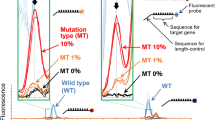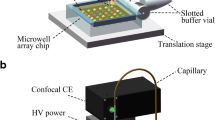Abstract
Automation is essential for rapid genetic-based mutation analysis in clinical laboratory to screen a large number of DNA samples. We propose in this report an automatic process using Beckman Coulter P/ACE™ capillary electrophoresis (CE) with laser-induced fluorescence (LIF) system to detect a single-point mutation in the codon 12 of human K-ras gene. Polymerase chain reaction (PCR) using a fluorescently labeled reverse primer and a plain forward primer to specifically amplify a selected 50 bp DNA fragment in human K-ras gene. The amplified DNA is placed on the sample tray of the CE system with a pre-programmed step for single-strand conformation polymorphism (SSCP) analysis. Sample injection and denaturation processes are performed online along with separation and real-time data analysis. The concept of automation for rapid DNA mutation analysis using CE-LIF system for SSCP is presented.
Similar content being viewed by others
References
Rolfs, A., L. Schuller, U. Finckh, and I. Weber-Rolfs. 1992. PCR: Clinical Diagnostics and Research: Springer-Verlag, Berlin.
Nollau, P. and C. Wagener. 1997. Methods for detection of point mutations: performance and quality assessment. Clin. Chem. 43, 1114–1128.
Orita, M., H. Iwahara, H. Kanazawa, K. Hayashi, and T. Sekiya. 1989. Detection of polymorphisms of human DNA by gel electrophoresis as single -strand conformation polymorphism. Proc. Natl. Acad. Sci. USA 86, 2766–2770.
Hayashi, K. 1992. PCR-SSCP: A method for detection of mutations. GATA 9, 73–79.
Landers, J.P., R.P. Oda, T.C. Spelsberg, J.A. Nolan, and K.J. Ulfelder. 1993. Capillary electrophoresis: A powerful mircoanalytical technique for biologically active molecules. Biotechniques 14, 98–111.
Ren, J., A. Ulvik, P.M. Ueland, and H. Refsum. 1997. Analysis of single-strand conformation polymorphism by capillary electrophoresis with laser-induced fluorescence detection using short-chain polyacrylamide as sieving medium. Anal. Biochem. 245, 79–84.
Kuypers, A.W., P.M. Willems, M.J. van der Schans, P.C.M. Linssen, H.M.C. Wessels, C.H.M.M. De Bruijn, et al. 1993. Detection of point mutations in DNA using capillary electrophoresis in a polymer network. J. Chromatogr. 621, 149–156.
Liu, M.S. and F.A.T. Chen. 1996. Rapid analysis of amplified double-stranded DNA by capillary electrophoresis with laser-induced fluorescence detection. Clin. Chem. 42, 1106–1107.
Author information
Authors and Affiliations
Corresponding author
Rights and permissions
About this article
Cite this article
Liu, MS., Rampal, S., Hsiang, D. et al. Automated DNA mutation analysis by single-strand conformation polymorphism using capillary electrophoresis with laser-induced fluorescence detection. Mol Biotechnol 15, 21–27 (2000). https://doi.org/10.1385/MB:15:1:21
Issue Date:
DOI: https://doi.org/10.1385/MB:15:1:21




